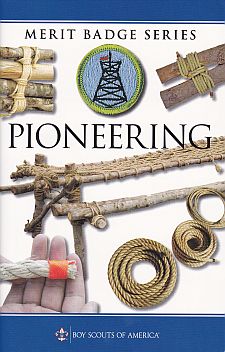Requirement 2a should have been revised in 2016. See the note below.
- Do the following:
- Explain to your counselor the most likely hazards you might encounter while participating in pioneering activities and what you should do to anticipate, help prevent, mitigate, and respond to these hazards.
- Discuss the prevention of, and first aid treatment for, injuries and conditions that could occur while working on pioneering projects, including cuts, scratches, insect bites and stings, rope burns, hypothermia, dehydration, heat exhaustion, heatstroke, sunburn, and falls.
- Do the following:
- Successfully complete Tenderfoot requirements 4a and 4b and First Class requirements 7a, 7b, and 8a. (These are the rope-related requirements.)
- Tie the following: square knot, bowline, sheepshank, sheet bend, and roundturn with two half hitches.
- Demonstrate the following: tripod and round lashings.
- Explain why it is useful to be able to throw a rope, then demonstrate how to coil and throw a 40-foot length of 1/4- or 3/8-inch rope. Explain how to improve your throwing distance by adding weight to the end of your rope.
- Explain the differences between synthetic ropes and natural-fiber ropes. Discuss which types of rope are suitable for pioneering work and why. Include the following in your discussion: breaking strength, safe working loads, and the care and storage of rope.
- Explain the uses for the back splice, eye splice, and short splice. Using 1/4- or 3/8-inch three-stranded rope, demonstrate how to form each splice.
- Using a rope-making device or machine, make a rope at least 6 feet long consisting of three strands, each having three yarns.
- Build a scale model of a signal tower or a monkey bridge. Correctly anchor the model using either the 1-1-1 anchoring system or the log and stake anchoring method. Describe the design of your project and explain how the anchoring system works.
- Demonstrate the use of rope tackle to lift a weight of 25 pounds and pulling a log at least 6 inches in diameter and 6 feet long with the tackle. Use the tackle to put tension on a line. Explain the advantages and limitations of using a rope tackle. In your explanation, describe the potential damage that friction can do to a rope.
- By yourself, build an A-trestle OR X-trestle OR H-trestle using square and diagonal lashings. Explain the application of the trestle you build. Demonstrate how to tie two spars together using a shear lashing.
- With a group of Scouts, OR on your own, select a pioneering project and get your counselor's approval before you begin building. Your project must not result in anyone reaching a height of greater than 6 feet off the ground. With your counselor's guidance, create a rough sketch of the project. Make a list of the ropes and spars needed, then build the project. (Note: This requirement may be done at summer camp, at district or council events, or on a troop camp outing.)
Requirement 2a was not revised when the rank requirements were revised in 2016. To require the same basic tasks, it should read as follows:
-
- Successfully complete Scout requirements 4a and 4b, Second Class requirement 2g, and First Class requirements 3a, 3b, 3c, and 3d. (These are the rope-related requirements.)
- Scout
-
- Show how to tie a square knot, two half-hitches, and a taut-line hitch. Explain how each knot is used.
- Show the proper care of a rope by learning how to whip and fuse the ends of different kinds of rope.
-
- Second Class
-
- Demonstrate how to tie the bowline knot. Describe a situation in which you would use this knot.
-
- First Class
-
- Discuss when you should and should not use lashings.
- Demonstrate tying the timber hitch and clove hitch.
- Demonstrate tying the square, shear, and diagonal lashings by joining two or more poles or staves together.
- Use lashings to make a useful camp gadget or structure.
-
BSA Advancement ID#:
84
Requirements last updated in:
2014
Pamphlet Stock Number:
35931
Pamphlet SKU Number:
618702
Pamphlet Revision Date:
2013
|
|||||||
Page updated on: May 08, 2022









